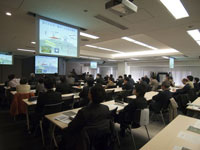 |
 |
|||||||||||||
|
|||||||||||||
|
|||||||||||||
|
The word quantum beam, or Ryo-shi beam in Japanese, defined as high-quality beams produced with accelerated leptons or hadrons applying quantum mechanics, isn't really an academic word, but rather a key word for advanced technology. But it is gradually getting its recognition in Japan as a technology that will achieve breakthroughs in many fields, such as new materials developments, nanofabrication, or medical applications.
“We recognise photon beams and quantum beams as promising technologies, and started up the project in 2008 to develop fundamental technologies which utilise the photon and quantum beam,” said Hiroki Takaya, Director of the office of Synchrotron Radiation Research, Ministry of Education, Culture, Sports, Science and Technology (MEXT) at a symposium held on 25 February in Tokyo. “We aim to fuse together the needs in important research fields and industries, and technological seeds and potentials in the research on photon and quantum-beam science, by the research collaboration through Japan,” Takaya said. Their plan is to establish a network of research laboratories, universities, and industries to create new insights, and strengthen the international competitiveness. The project consists of two programmes: one for photon science, and another for quantum-beam science. The latter is further broken up into five programmes in two categories: one to utilise existing facilities for developing advanced technologies (four programmes), and one to develop new research facility — a programme currently ongoing centred at KEK and lead by Junji Urakawa, former spokesperson for the Accelerator Test Facility collaboration. “We use superconducting radiofrequency (RF) cavities developed through ILC R&D for our new devise called the Compact High-brightness X-ray Source,” said Urakawa. This new X-ray source will enable each university or company to conduct high-level research by drastically downsizing the research facility. “We anticipate many direct impacts of this technology to the society, such as new medicine design, medical applications or micro lithography,” he added. Urakawa's team also applies other ILC technologies like RF source. The positions of those research programmes within the research landscape are, however, not very clear. “It is often called 'Death Valley,” said Makoto Inoue, Professor Emeritus of Kyoto University, a programme director of the quantum-beam project. The research at this stage stands between basic science and technology application. A trial-and-error process is very important at this stage, and scientists do not strictly examine the programme from an economical or cost point of view. Therefore, economical or social impacts of the research cannot be clearly presented. The new Japanese government is evaluating the budget to screen out any wasteful projects since the Democratic Party of Japan took office last September, and some of the science projects and programmes have suffered from drastic budget cuts. “We need to strive to gain understanding and support from public through our communication efforts,” Inoue said. The effort to send the message of the importance, significance of the project and scientists' devotion to the research seem to have become one of the most important factor of the research. -- Rika Takahashi |
|||||||||||||
| © International Linear Collider |
